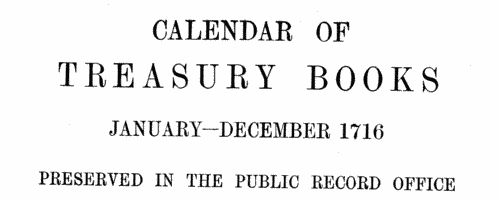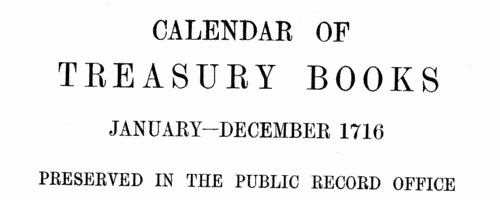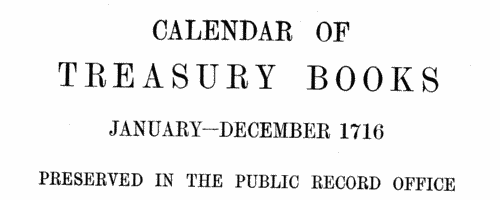Add this eBook to your basket to receive access to all 1,134 records. Our indexes include entries for the spelling bourne. In the period you have requested, we have the following 1,134 records (displaying 171 to 180): These sample scans are from the original record. You will get scans of the full pages or articles where the surname you searched for has been found. Your web browser may prevent the sample windows from opening; in this case please change your browser settings to allow pop-up windows from this site. Army Pensions
(1715-1716)
Abstract of the Treasury declared accounts for the Army, Guards and Garrisons and Land Forces, 17 October 1715 to 24 December 1716: E 351/103. The names of officers receiving pensions and allowances. | Sample scan, click to enlarge

| Army Regiments
(1715-1716)
Abstract of the Treasury declared accounts for the Army, Guards and Garrisons and Land Forces, 17 October 1715 to 24 December 1716: E 351/103. The names of officers receiving payments for regimental expenses. | Sample scan, click to enlarge

| Customs Officers
(1715-1716)
Abstract of the Treasury declared accounts for the Customs: General Account, Christmas 1715 to Christmas 1716, AO 1/644/246; Cash Account, Christmas 1715 to Midsummer 1716, AO 1/786/985; Tobacco, General Account, Christmas 1715 to Christmas 1716, AO 1/645/249, and Cash Account, Midsummer to Christmas 1716, AO 1/787/993; Wines and Vinegar, General Account, Christmas 1715 to Christmas 1716, AO 1/645/248, and Cash Account, Christmas 1715 to Midsummer 1716, AO 1/786/987; Silks and Linens, General Account, Christmas 1715 to Christmas 1716, AO 1/645/247, and Cash Account, Christmas 1715 to Midsummer 1716, AO 1/786/986. Most, but not all, of the names which appear in these accounts are those of the customs officers at London and the outports throughout the kingdom. | Sample scan, click to enlarge

|  Masters and Apprentices
(1716) Masters and Apprentices
(1716)
Apprenticeship indentures and clerks' articles were subject to a 6d or 12d per pound stamp duty: the registers of the payments usually give the master's trade, address, and occupation, and the apprentice's father's name and address, as well as details of the date and length of the apprenticeship. 3 August to 31 December 1716. | Sample scan, click to enlarge

|  Masters and Apprentices
(1716) Masters and Apprentices
(1716)
Apprenticeship indentures and clerks' articles were subject to a 6d or 12d per pound stamp duty: the registers of the payments usually give the master's trade, address, and occupation, and the apprentice's father's name and address, as well as details of the date and length of the apprenticeship. 1 January to 2 August 1716. | Sample scan, click to enlarge

|  Apprentices registered at Bedford
(1715-1717) Apprentices registered at Bedford
(1715-1717)
Apprenticeship indentures and clerks' articles were subject to a 6d or 12d per pound stamp duty: the registers of the payments usually give the master's trade, address, and occupation, and the apprentice's father's name and address, as well as details of the date and length of the apprenticeship. There are central registers for collections of the stamp duty in London, as well as returns from collectors in the provinces. These collectors generally received duty just from their own county, but sometimes from further afield. Because of the delay before some collectors made their returns, this register includes indentures and articles from as early as 1714. (The sample entry shown on this scan is taken from a Norfolk return) | Sample scan, click to enlarge

|  Masters of Apprentices registered at Newcastle under Lyme in Staffordshire
(1715-1717) Masters of Apprentices registered at Newcastle under Lyme in Staffordshire
(1715-1717)
Apprenticeship indentures and clerks' articles were subject to a 6d or 12d per pound stamp duty: the registers of the payments usually give the master's trade, address, and occupation, and the apprentice's father's name and address, as well as details of the date and length of the apprenticeship. There are central registers for collections of the stamp duty in London, as well as returns from collectors in the provinces. These collectors generally received duty just from their own county, but sometimes from further afield. Because of the delay before some collectors made their returns, this register includes indentures and articles from as early as 1714. (The sample entry shown on this scan is taken from a Norfolk return) | Sample scan, click to enlarge

|  Masters of Apprentices registered at Stroud in Gloucestershire
(1715-1717) Masters of Apprentices registered at Stroud in Gloucestershire
(1715-1717)
Apprenticeship indentures and clerks' articles were subject to a 6d or 12d per pound stamp duty: the registers of the payments usually give the master's trade, address, and occupation, and the apprentice's father's name and address, as well as details of the date and length of the apprenticeship. There are central registers for collections of the stamp duty in London, as well as returns from collectors in the provinces. These collectors generally received duty just from their own county, but sometimes from further afield. Because of the delay before some collectors made their returns, this register includes indentures and articles from as early as 1714. (The sample entry shown on this scan is taken from a Norfolk return) | Sample scan, click to enlarge

|  Masters of Apprentices registered at Wells in Somerset
(1715-1717) Masters of Apprentices registered at Wells in Somerset
(1715-1717)
Apprenticeship indentures and clerks' articles were subject to a 6d or 12d per pound stamp duty: the registers of the payments usually give the master's trade, address, and occupation, and the apprentice's father's name and address, as well as details of the date and length of the apprenticeship. There are central registers for collections of the stamp duty in London, as well as returns from collectors in the provinces. These collectors generally received duty just from their own county, but sometimes from further afield. Because of the delay before some collectors made their returns, this register includes indentures and articles from as early as 1714. (The sample entry shown on this scan is taken from a Norfolk return) | Sample scan, click to enlarge

|  Masters and Apprentices
(1717) Masters and Apprentices
(1717)
Apprenticeship indentures and clerks' articles were subject to a 6d or 12d per pound stamp duty: the registers of the payments usually give the master's trade, address, and occupation, and the apprentice's father's name and address, as well as details of the date and length of the apprenticeship. 4 November to 31 December 1717. | Sample scan, click to enlarge

|
Research your ancestry, family history, genealogy and one-name study by direct access to original records and archives indexed by surname.
|












